Energy Efficiency and Life Cycle Assessment of Lighting Systems Report
VerifiedAdded on 2023/03/30
|15
|2109
|309
Report
AI Summary
This report presents a comprehensive analysis of energy efficiency and life cycle assessment (LCA) for two different lighting systems: LED globes and incandescent bulbs. The analysis follows the guidelines set by the International Organization of Standards (ISO) and utilizes the GaBi application for LCA. The report includes an executive summary, introduction outlining the problem statement of the report, a detailed comparison of the two lighting options, considering factors like lifespan, carbon emissions, energy consumption, and cost. The analysis reveals that the incandescent bulb is the best alternative compared to the LED bulb. This analysis is conducted to determine which lighting system is more sustainable. The report concludes with recommendations and references. The second part of the report also compares different aspects of three types of fridges, including the cost and efficiency of the appliances and which one is the most efficient.
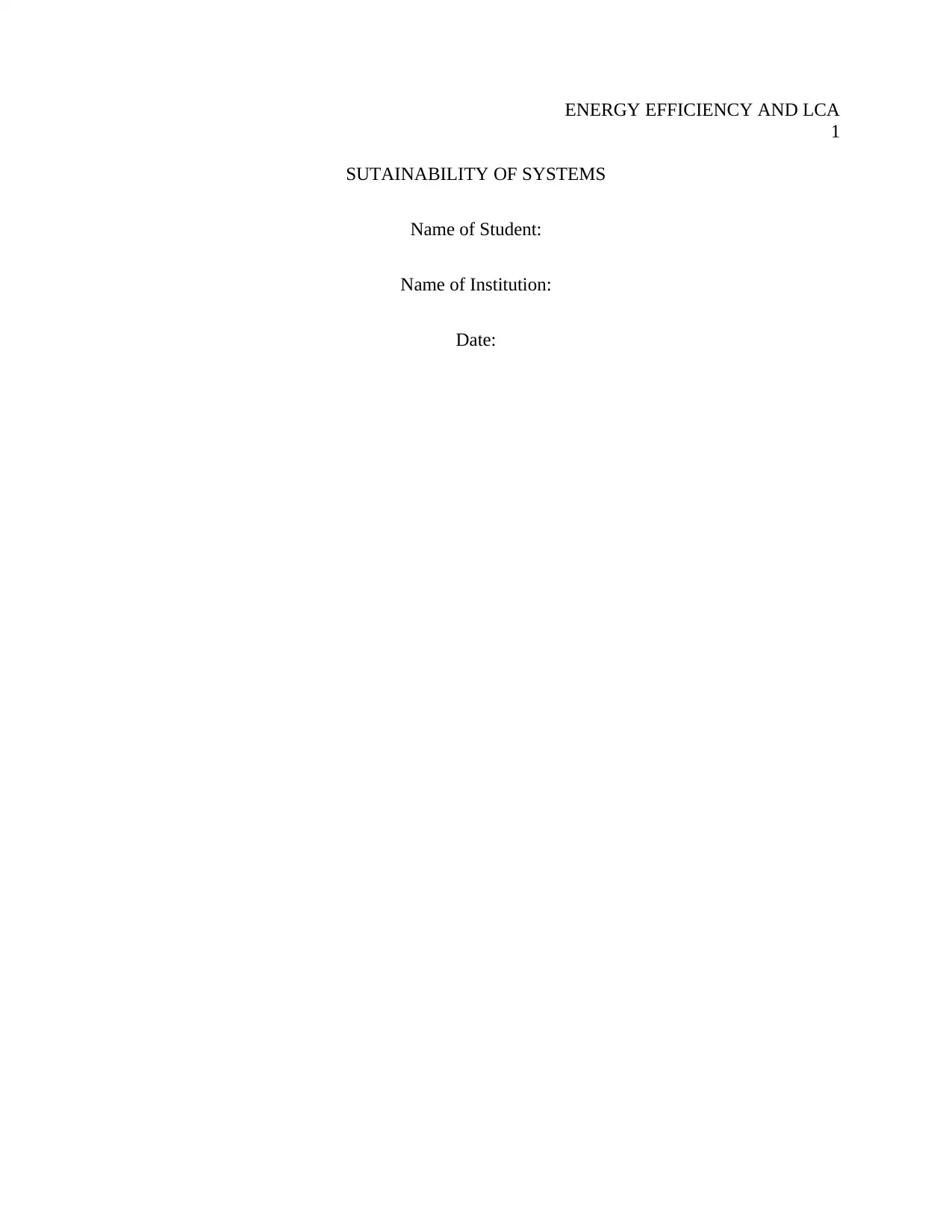
ENERGY EFFICIENCY AND LCA
1
SUTAINABILITY OF SYSTEMS
Name of Student:
Name of Institution:
Date:
1
SUTAINABILITY OF SYSTEMS
Name of Student:
Name of Institution:
Date:
Paraphrase This Document
Need a fresh take? Get an instant paraphrase of this document with our AI Paraphraser
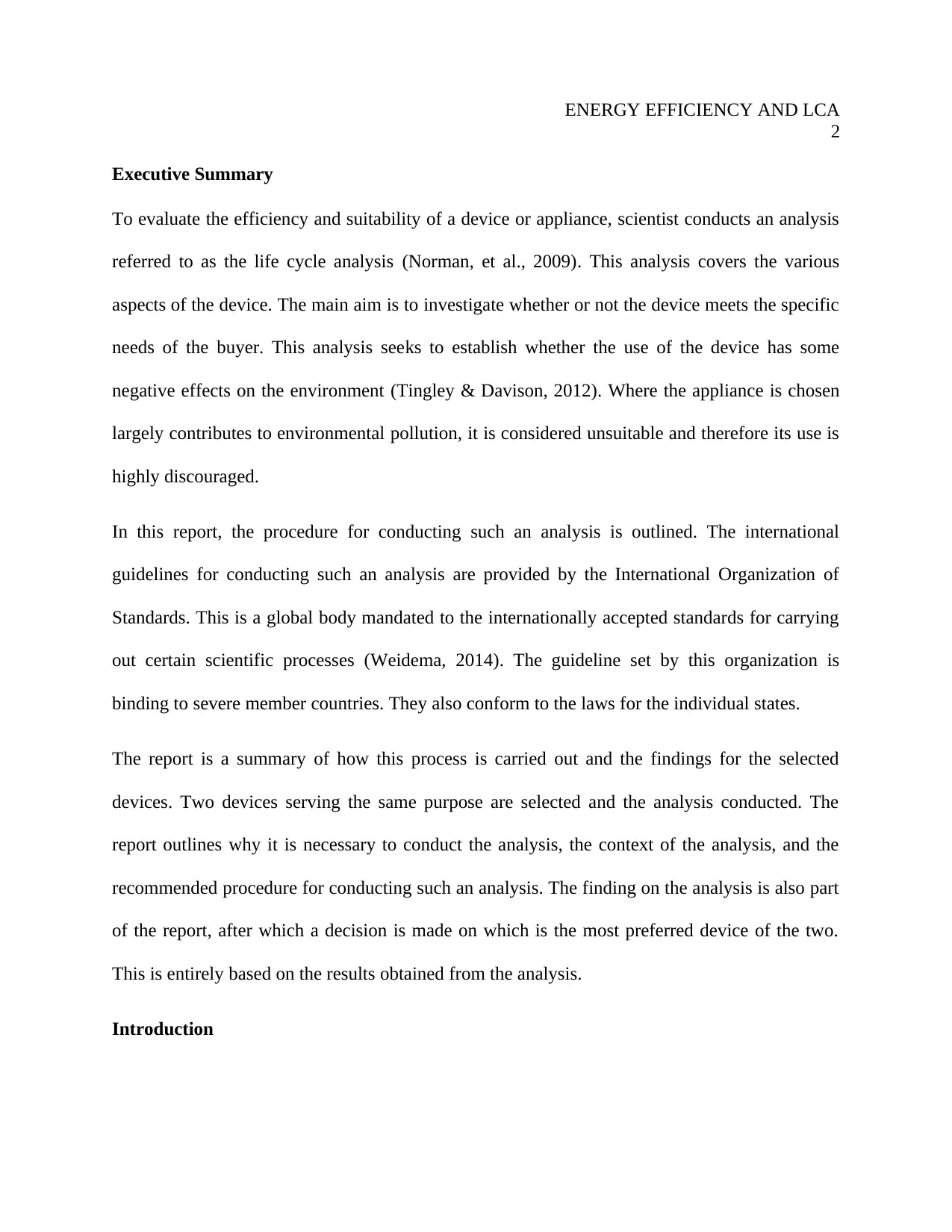
ENERGY EFFICIENCY AND LCA
2
Executive Summary
To evaluate the efficiency and suitability of a device or appliance, scientist conducts an analysis
referred to as the life cycle analysis (Norman, et al., 2009). This analysis covers the various
aspects of the device. The main aim is to investigate whether or not the device meets the specific
needs of the buyer. This analysis seeks to establish whether the use of the device has some
negative effects on the environment (Tingley & Davison, 2012). Where the appliance is chosen
largely contributes to environmental pollution, it is considered unsuitable and therefore its use is
highly discouraged.
In this report, the procedure for conducting such an analysis is outlined. The international
guidelines for conducting such an analysis are provided by the International Organization of
Standards. This is a global body mandated to the internationally accepted standards for carrying
out certain scientific processes (Weidema, 2014). The guideline set by this organization is
binding to severe member countries. They also conform to the laws for the individual states.
The report is a summary of how this process is carried out and the findings for the selected
devices. Two devices serving the same purpose are selected and the analysis conducted. The
report outlines why it is necessary to conduct the analysis, the context of the analysis, and the
recommended procedure for conducting such an analysis. The finding on the analysis is also part
of the report, after which a decision is made on which is the most preferred device of the two.
This is entirely based on the results obtained from the analysis.
Introduction
2
Executive Summary
To evaluate the efficiency and suitability of a device or appliance, scientist conducts an analysis
referred to as the life cycle analysis (Norman, et al., 2009). This analysis covers the various
aspects of the device. The main aim is to investigate whether or not the device meets the specific
needs of the buyer. This analysis seeks to establish whether the use of the device has some
negative effects on the environment (Tingley & Davison, 2012). Where the appliance is chosen
largely contributes to environmental pollution, it is considered unsuitable and therefore its use is
highly discouraged.
In this report, the procedure for conducting such an analysis is outlined. The international
guidelines for conducting such an analysis are provided by the International Organization of
Standards. This is a global body mandated to the internationally accepted standards for carrying
out certain scientific processes (Weidema, 2014). The guideline set by this organization is
binding to severe member countries. They also conform to the laws for the individual states.
The report is a summary of how this process is carried out and the findings for the selected
devices. Two devices serving the same purpose are selected and the analysis conducted. The
report outlines why it is necessary to conduct the analysis, the context of the analysis, and the
recommended procedure for conducting such an analysis. The finding on the analysis is also part
of the report, after which a decision is made on which is the most preferred device of the two.
This is entirely based on the results obtained from the analysis.
Introduction
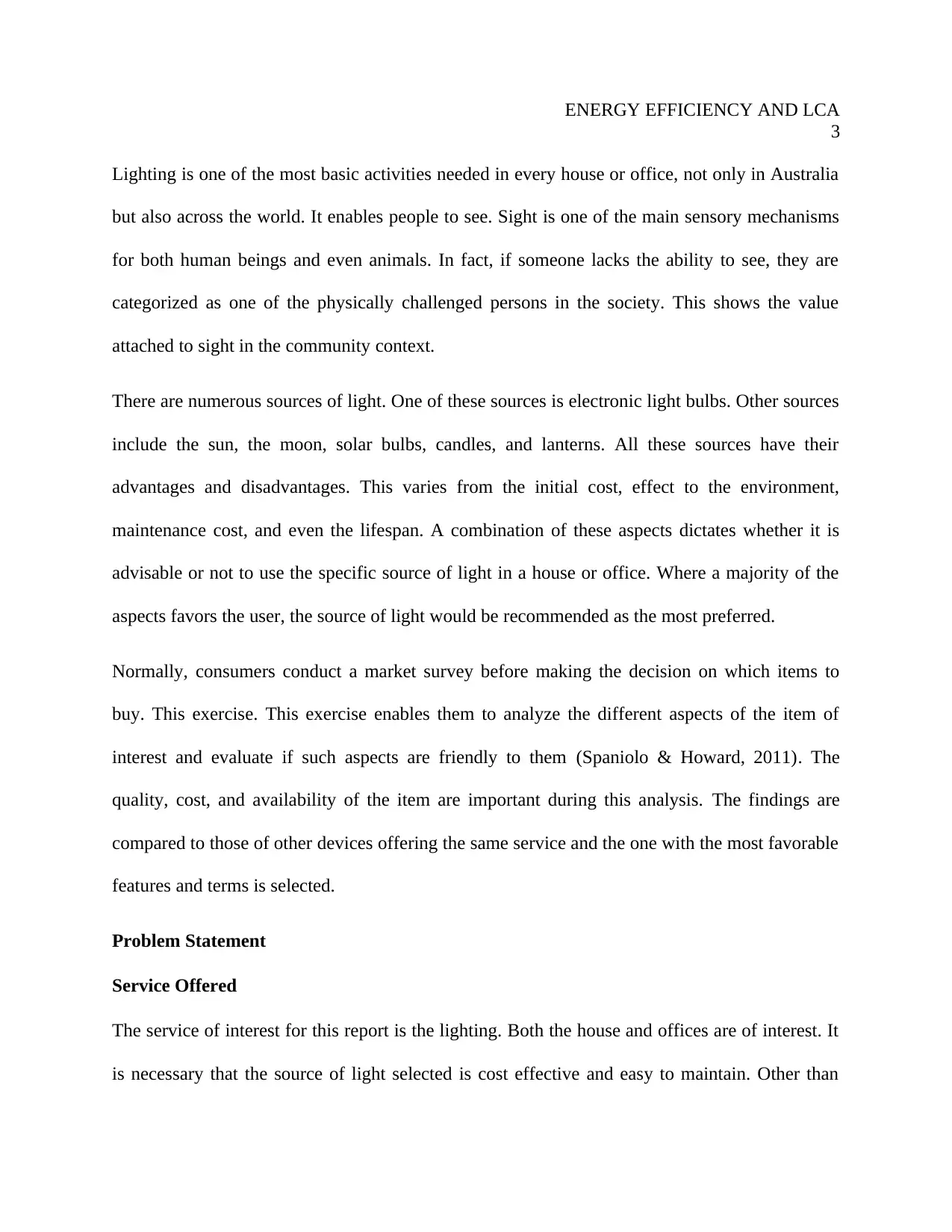
ENERGY EFFICIENCY AND LCA
3
Lighting is one of the most basic activities needed in every house or office, not only in Australia
but also across the world. It enables people to see. Sight is one of the main sensory mechanisms
for both human beings and even animals. In fact, if someone lacks the ability to see, they are
categorized as one of the physically challenged persons in the society. This shows the value
attached to sight in the community context.
There are numerous sources of light. One of these sources is electronic light bulbs. Other sources
include the sun, the moon, solar bulbs, candles, and lanterns. All these sources have their
advantages and disadvantages. This varies from the initial cost, effect to the environment,
maintenance cost, and even the lifespan. A combination of these aspects dictates whether it is
advisable or not to use the specific source of light in a house or office. Where a majority of the
aspects favors the user, the source of light would be recommended as the most preferred.
Normally, consumers conduct a market survey before making the decision on which items to
buy. This exercise. This exercise enables them to analyze the different aspects of the item of
interest and evaluate if such aspects are friendly to them (Spaniolo & Howard, 2011). The
quality, cost, and availability of the item are important during this analysis. The findings are
compared to those of other devices offering the same service and the one with the most favorable
features and terms is selected.
Problem Statement
Service Offered
The service of interest for this report is the lighting. Both the house and offices are of interest. It
is necessary that the source of light selected is cost effective and easy to maintain. Other than
3
Lighting is one of the most basic activities needed in every house or office, not only in Australia
but also across the world. It enables people to see. Sight is one of the main sensory mechanisms
for both human beings and even animals. In fact, if someone lacks the ability to see, they are
categorized as one of the physically challenged persons in the society. This shows the value
attached to sight in the community context.
There are numerous sources of light. One of these sources is electronic light bulbs. Other sources
include the sun, the moon, solar bulbs, candles, and lanterns. All these sources have their
advantages and disadvantages. This varies from the initial cost, effect to the environment,
maintenance cost, and even the lifespan. A combination of these aspects dictates whether it is
advisable or not to use the specific source of light in a house or office. Where a majority of the
aspects favors the user, the source of light would be recommended as the most preferred.
Normally, consumers conduct a market survey before making the decision on which items to
buy. This exercise. This exercise enables them to analyze the different aspects of the item of
interest and evaluate if such aspects are friendly to them (Spaniolo & Howard, 2011). The
quality, cost, and availability of the item are important during this analysis. The findings are
compared to those of other devices offering the same service and the one with the most favorable
features and terms is selected.
Problem Statement
Service Offered
The service of interest for this report is the lighting. Both the house and offices are of interest. It
is necessary that the source of light selected is cost effective and easy to maintain. Other than
⊘ This is a preview!⊘
Do you want full access?
Subscribe today to unlock all pages.

Trusted by 1+ million students worldwide
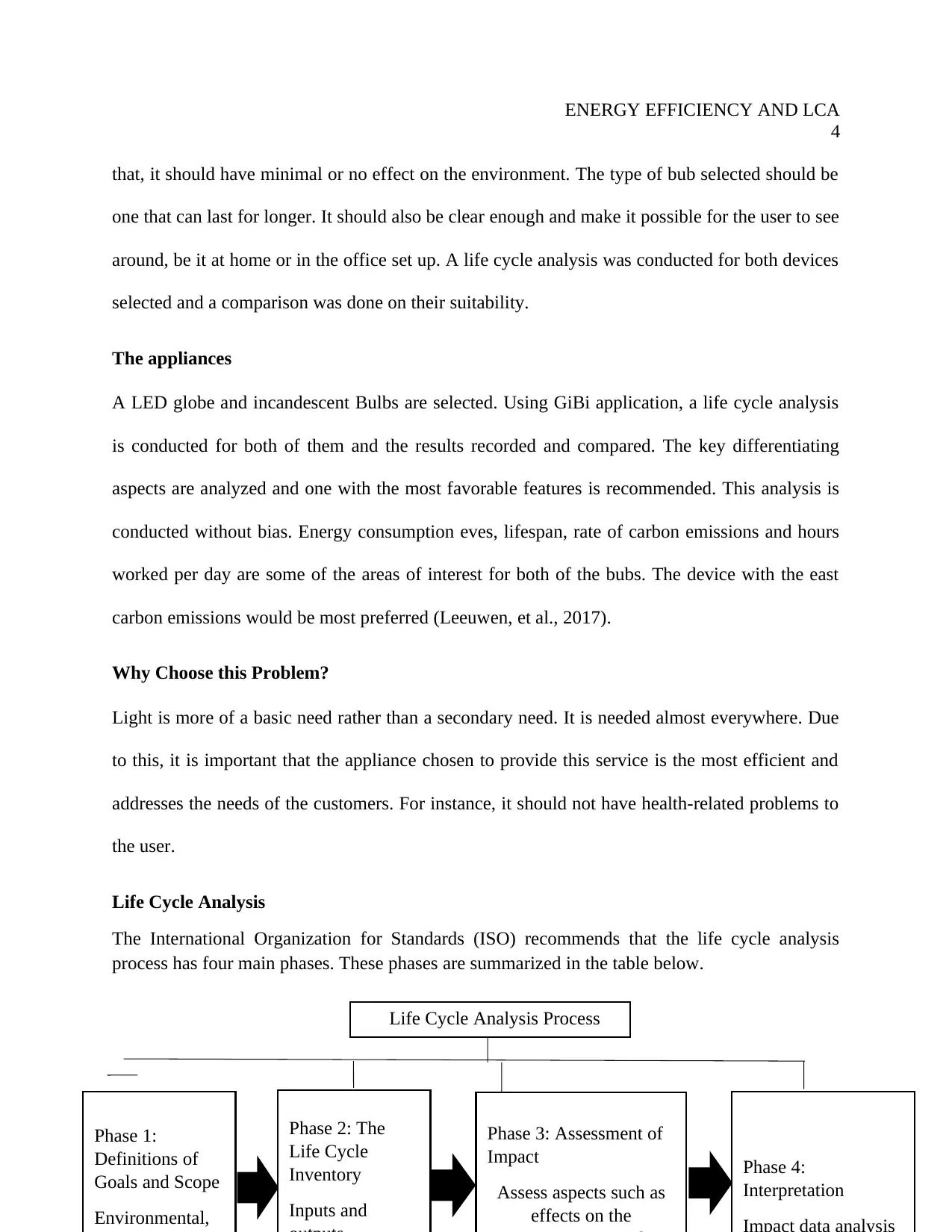
ENERGY EFFICIENCY AND LCA
4
that, it should have minimal or no effect on the environment. The type of bub selected should be
one that can last for longer. It should also be clear enough and make it possible for the user to see
around, be it at home or in the office set up. A life cycle analysis was conducted for both devices
selected and a comparison was done on their suitability.
The appliances
A LED globe and incandescent Bulbs are selected. Using GiBi application, a life cycle analysis
is conducted for both of them and the results recorded and compared. The key differentiating
aspects are analyzed and one with the most favorable features is recommended. This analysis is
conducted without bias. Energy consumption eves, lifespan, rate of carbon emissions and hours
worked per day are some of the areas of interest for both of the bubs. The device with the east
carbon emissions would be most preferred (Leeuwen, et al., 2017).
Why Choose this Problem?
Light is more of a basic need rather than a secondary need. It is needed almost everywhere. Due
to this, it is important that the appliance chosen to provide this service is the most efficient and
addresses the needs of the customers. For instance, it should not have health-related problems to
the user.
Life Cycle Analysis
The International Organization for Standards (ISO) recommends that the life cycle analysis
process has four main phases. These phases are summarized in the table below.
Life Cycle Analysis Process
Phase 1:
Definitions of
Goals and Scope
Environmental,
Phase 2: The
Life Cycle
Inventory
Inputs and
Phase 3: Assessment of
Impact
Assess aspects such as
effects on the
Phase 4:
Interpretation
Impact data analysis
4
that, it should have minimal or no effect on the environment. The type of bub selected should be
one that can last for longer. It should also be clear enough and make it possible for the user to see
around, be it at home or in the office set up. A life cycle analysis was conducted for both devices
selected and a comparison was done on their suitability.
The appliances
A LED globe and incandescent Bulbs are selected. Using GiBi application, a life cycle analysis
is conducted for both of them and the results recorded and compared. The key differentiating
aspects are analyzed and one with the most favorable features is recommended. This analysis is
conducted without bias. Energy consumption eves, lifespan, rate of carbon emissions and hours
worked per day are some of the areas of interest for both of the bubs. The device with the east
carbon emissions would be most preferred (Leeuwen, et al., 2017).
Why Choose this Problem?
Light is more of a basic need rather than a secondary need. It is needed almost everywhere. Due
to this, it is important that the appliance chosen to provide this service is the most efficient and
addresses the needs of the customers. For instance, it should not have health-related problems to
the user.
Life Cycle Analysis
The International Organization for Standards (ISO) recommends that the life cycle analysis
process has four main phases. These phases are summarized in the table below.
Life Cycle Analysis Process
Phase 1:
Definitions of
Goals and Scope
Environmental,
Phase 2: The
Life Cycle
Inventory
Inputs and
Phase 3: Assessment of
Impact
Assess aspects such as
effects on the
Phase 4:
Interpretation
Impact data analysis
Paraphrase This Document
Need a fresh take? Get an instant paraphrase of this document with our AI Paraphraser
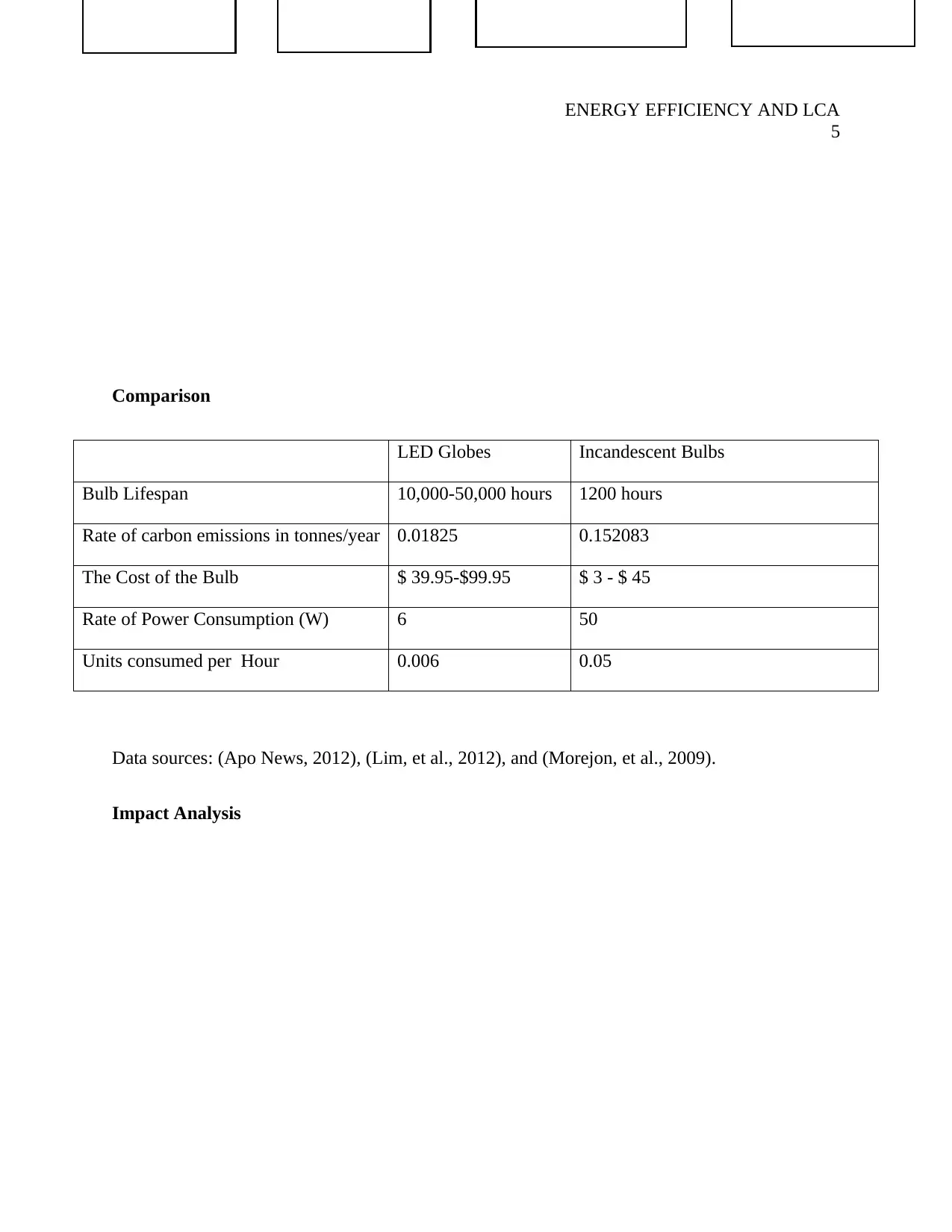
ENERGY EFFICIENCY AND LCA
5
Comparison
LED Globes Incandescent Bulbs
Bulb Lifespan 10,000-50,000 hours 1200 hours
Rate of carbon emissions in tonnes/year 0.01825 0.152083
The Cost of the Bulb $ 39.95-$99.95 $ 3 - $ 45
Rate of Power Consumption (W) 6 50
Units consumed per Hour 0.006 0.05
Data sources: (Apo News, 2012), (Lim, et al., 2012), and (Morejon, et al., 2009).
Impact Analysis
5
Comparison
LED Globes Incandescent Bulbs
Bulb Lifespan 10,000-50,000 hours 1200 hours
Rate of carbon emissions in tonnes/year 0.01825 0.152083
The Cost of the Bulb $ 39.95-$99.95 $ 3 - $ 45
Rate of Power Consumption (W) 6 50
Units consumed per Hour 0.006 0.05
Data sources: (Apo News, 2012), (Lim, et al., 2012), and (Morejon, et al., 2009).
Impact Analysis
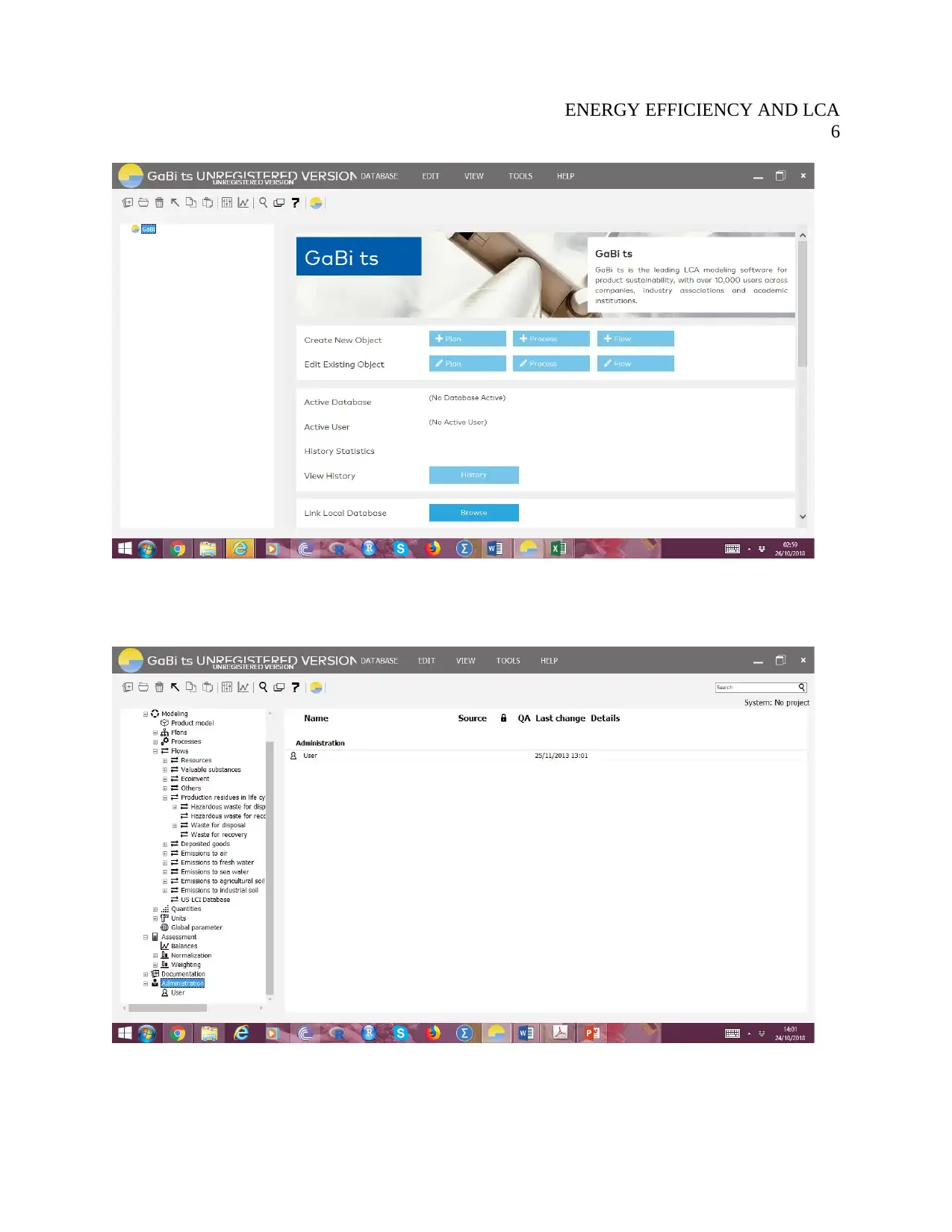
ENERGY EFFICIENCY AND LCA
6
6
⊘ This is a preview!⊘
Do you want full access?
Subscribe today to unlock all pages.

Trusted by 1+ million students worldwide
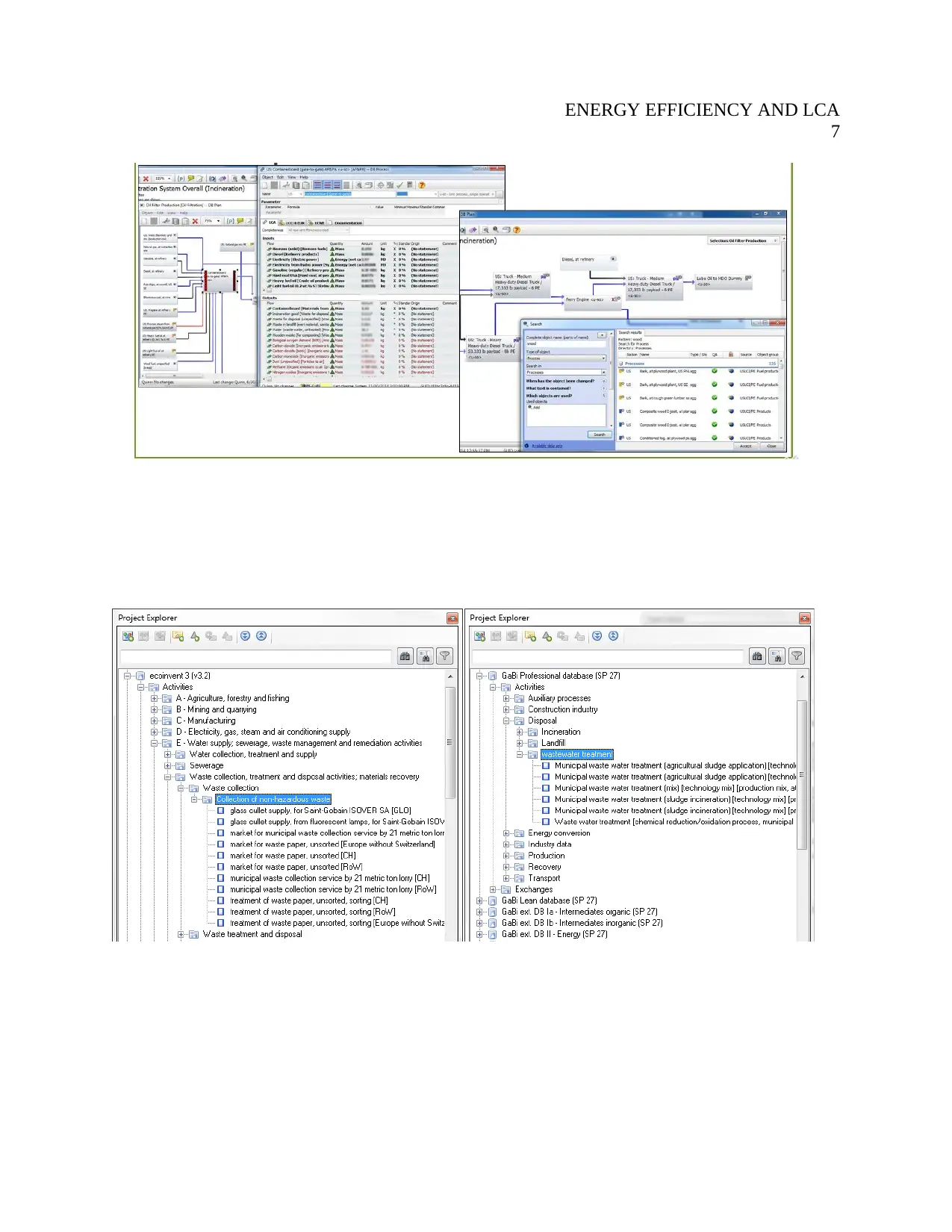
ENERGY EFFICIENCY AND LCA
7
7
Paraphrase This Document
Need a fresh take? Get an instant paraphrase of this document with our AI Paraphraser
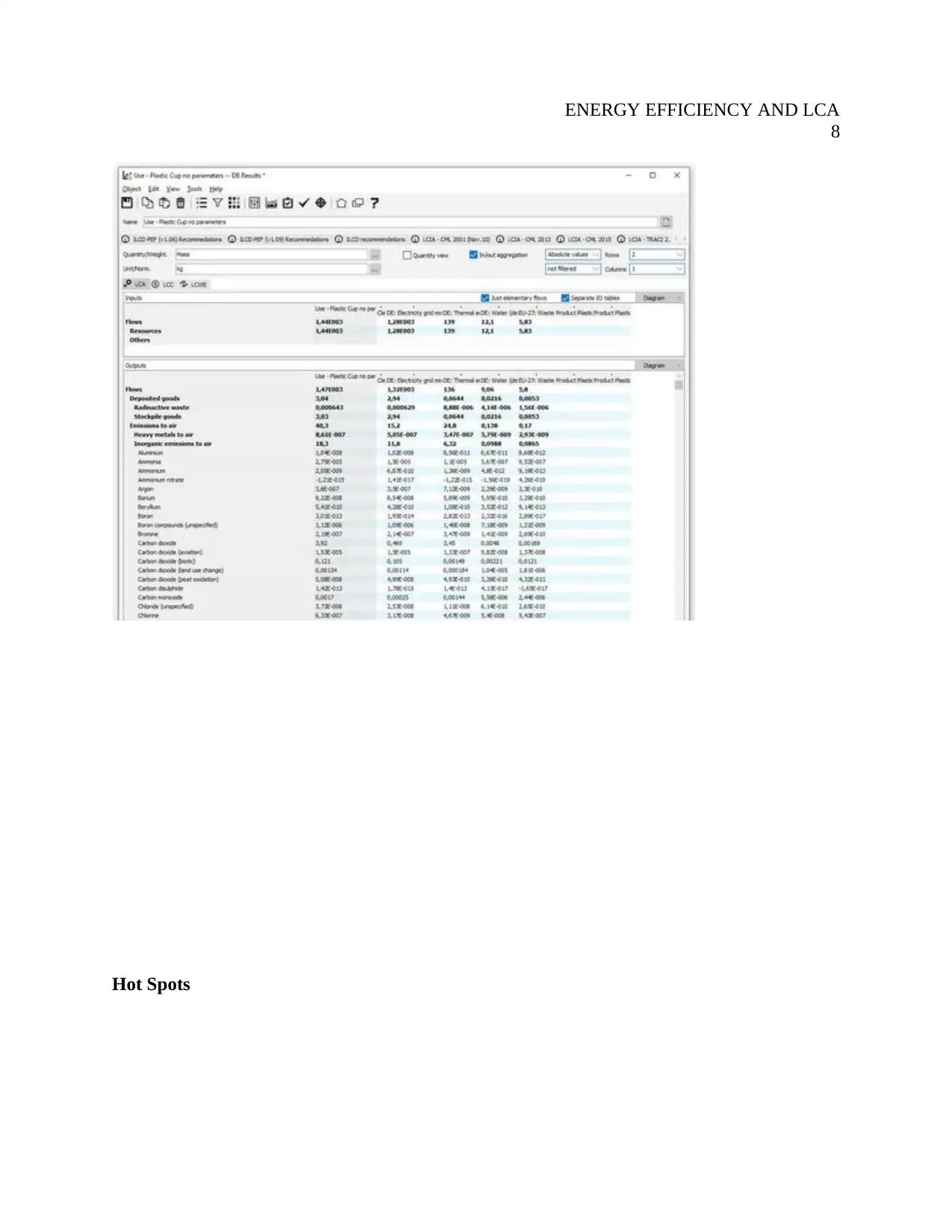
ENERGY EFFICIENCY AND LCA
8
Hot Spots
8
Hot Spots
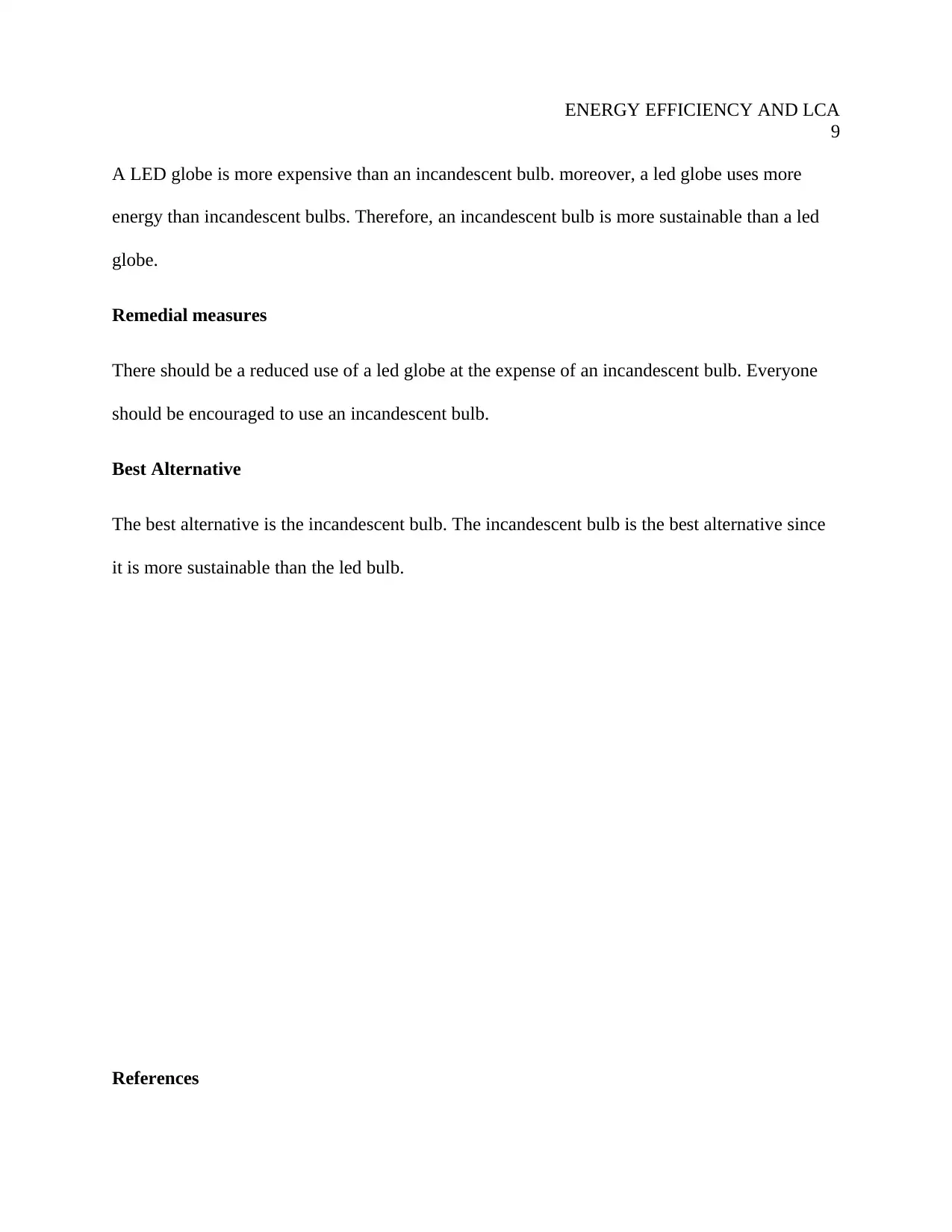
ENERGY EFFICIENCY AND LCA
9
A LED globe is more expensive than an incandescent bulb. moreover, a led globe uses more
energy than incandescent bulbs. Therefore, an incandescent bulb is more sustainable than a led
globe.
Remedial measures
There should be a reduced use of a led globe at the expense of an incandescent bulb. Everyone
should be encouraged to use an incandescent bulb.
Best Alternative
The best alternative is the incandescent bulb. The incandescent bulb is the best alternative since
it is more sustainable than the led bulb.
References
9
A LED globe is more expensive than an incandescent bulb. moreover, a led globe uses more
energy than incandescent bulbs. Therefore, an incandescent bulb is more sustainable than a led
globe.
Remedial measures
There should be a reduced use of a led globe at the expense of an incandescent bulb. Everyone
should be encouraged to use an incandescent bulb.
Best Alternative
The best alternative is the incandescent bulb. The incandescent bulb is the best alternative since
it is more sustainable than the led bulb.
References
⊘ This is a preview!⊘
Do you want full access?
Subscribe today to unlock all pages.

Trusted by 1+ million students worldwide
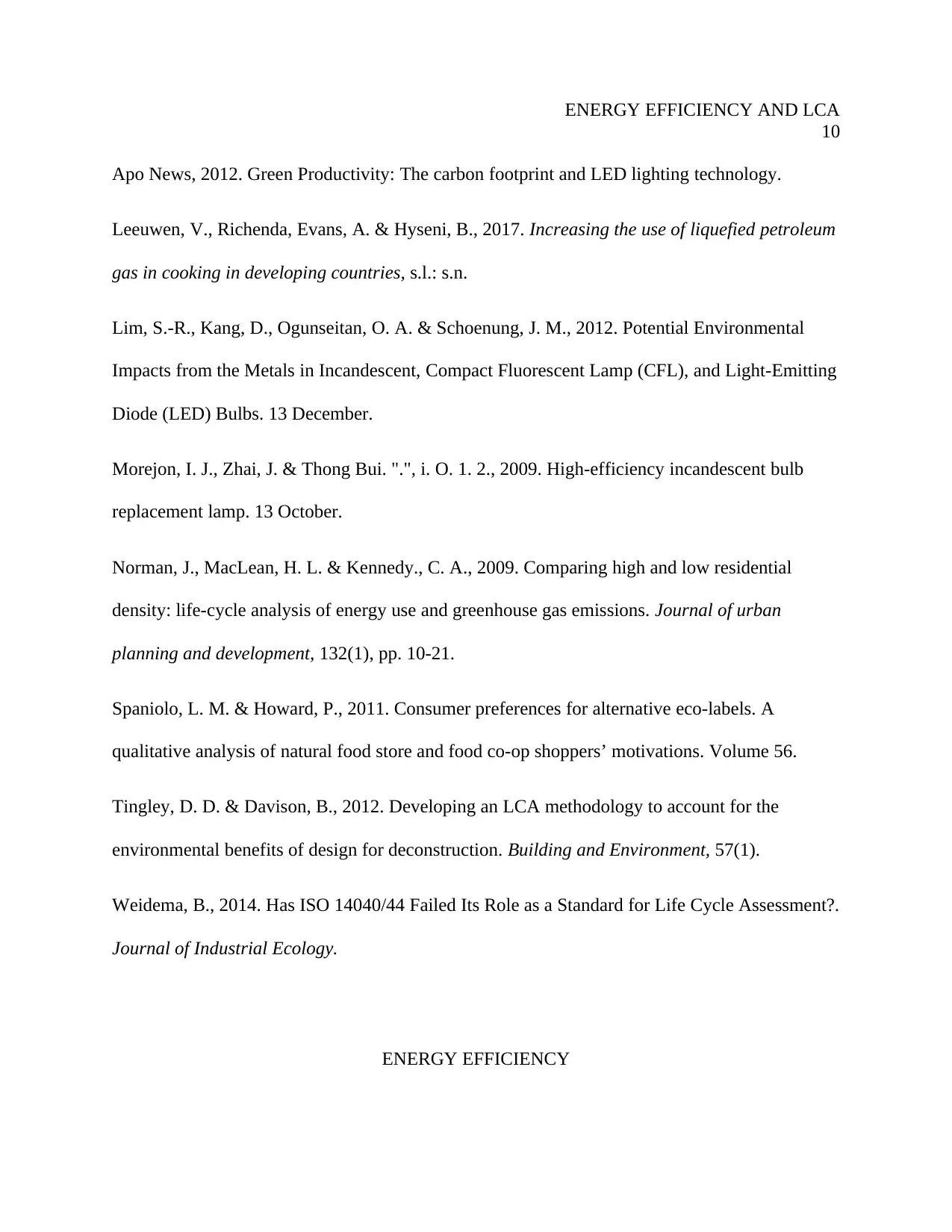
ENERGY EFFICIENCY AND LCA
10
Apo News, 2012. Green Productivity: The carbon footprint and LED lighting technology.
Leeuwen, V., Richenda, Evans, A. & Hyseni, B., 2017. Increasing the use of liquefied petroleum
gas in cooking in developing countries, s.l.: s.n.
Lim, S.-R., Kang, D., Ogunseitan, O. A. & Schoenung, J. M., 2012. Potential Environmental
Impacts from the Metals in Incandescent, Compact Fluorescent Lamp (CFL), and Light-Emitting
Diode (LED) Bulbs. 13 December.
Morejon, I. J., Zhai, J. & Thong Bui. ".", i. O. 1. 2., 2009. High-efficiency incandescent bulb
replacement lamp. 13 October.
Norman, J., MacLean, H. L. & Kennedy., C. A., 2009. Comparing high and low residential
density: life-cycle analysis of energy use and greenhouse gas emissions. Journal of urban
planning and development, 132(1), pp. 10-21.
Spaniolo, L. M. & Howard, P., 2011. Consumer preferences for alternative eco-labels. A
qualitative analysis of natural food store and food co-op shoppers’ motivations. Volume 56.
Tingley, D. D. & Davison, B., 2012. Developing an LCA methodology to account for the
environmental benefits of design for deconstruction. Building and Environment, 57(1).
Weidema, B., 2014. Has ISO 14040/44 Failed Its Role as a Standard for Life Cycle Assessment?.
Journal of Industrial Ecology.
ENERGY EFFICIENCY
10
Apo News, 2012. Green Productivity: The carbon footprint and LED lighting technology.
Leeuwen, V., Richenda, Evans, A. & Hyseni, B., 2017. Increasing the use of liquefied petroleum
gas in cooking in developing countries, s.l.: s.n.
Lim, S.-R., Kang, D., Ogunseitan, O. A. & Schoenung, J. M., 2012. Potential Environmental
Impacts from the Metals in Incandescent, Compact Fluorescent Lamp (CFL), and Light-Emitting
Diode (LED) Bulbs. 13 December.
Morejon, I. J., Zhai, J. & Thong Bui. ".", i. O. 1. 2., 2009. High-efficiency incandescent bulb
replacement lamp. 13 October.
Norman, J., MacLean, H. L. & Kennedy., C. A., 2009. Comparing high and low residential
density: life-cycle analysis of energy use and greenhouse gas emissions. Journal of urban
planning and development, 132(1), pp. 10-21.
Spaniolo, L. M. & Howard, P., 2011. Consumer preferences for alternative eco-labels. A
qualitative analysis of natural food store and food co-op shoppers’ motivations. Volume 56.
Tingley, D. D. & Davison, B., 2012. Developing an LCA methodology to account for the
environmental benefits of design for deconstruction. Building and Environment, 57(1).
Weidema, B., 2014. Has ISO 14040/44 Failed Its Role as a Standard for Life Cycle Assessment?.
Journal of Industrial Ecology.
ENERGY EFFICIENCY
Paraphrase This Document
Need a fresh take? Get an instant paraphrase of this document with our AI Paraphraser
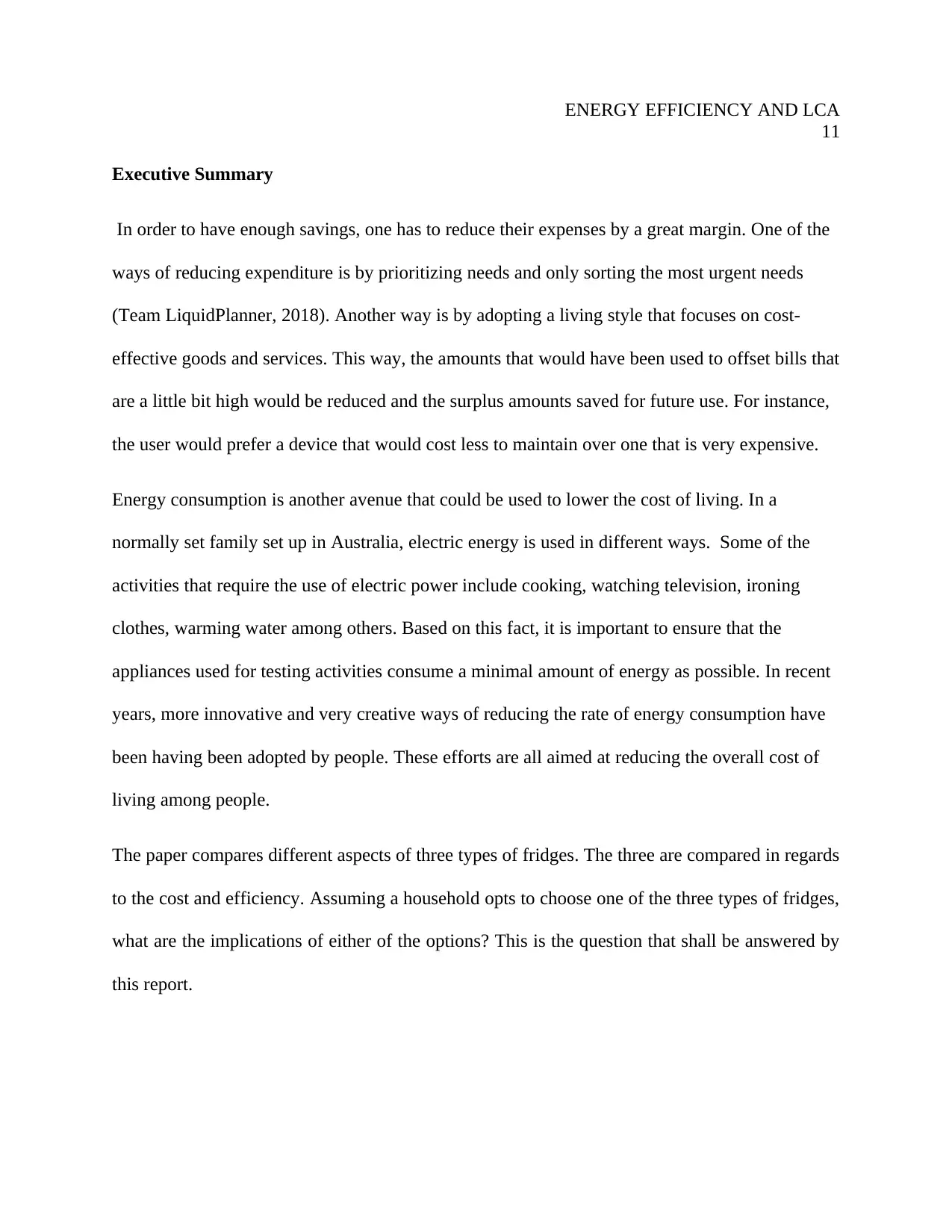
ENERGY EFFICIENCY AND LCA
11
Executive Summary
In order to have enough savings, one has to reduce their expenses by a great margin. One of the
ways of reducing expenditure is by prioritizing needs and only sorting the most urgent needs
(Team LiquidPlanner, 2018). Another way is by adopting a living style that focuses on cost-
effective goods and services. This way, the amounts that would have been used to offset bills that
are a little bit high would be reduced and the surplus amounts saved for future use. For instance,
the user would prefer a device that would cost less to maintain over one that is very expensive.
Energy consumption is another avenue that could be used to lower the cost of living. In a
normally set family set up in Australia, electric energy is used in different ways. Some of the
activities that require the use of electric power include cooking, watching television, ironing
clothes, warming water among others. Based on this fact, it is important to ensure that the
appliances used for testing activities consume a minimal amount of energy as possible. In recent
years, more innovative and very creative ways of reducing the rate of energy consumption have
been having been adopted by people. These efforts are all aimed at reducing the overall cost of
living among people.
The paper compares different aspects of three types of fridges. The three are compared in regards
to the cost and efficiency. Assuming a household opts to choose one of the three types of fridges,
what are the implications of either of the options? This is the question that shall be answered by
this report.
11
Executive Summary
In order to have enough savings, one has to reduce their expenses by a great margin. One of the
ways of reducing expenditure is by prioritizing needs and only sorting the most urgent needs
(Team LiquidPlanner, 2018). Another way is by adopting a living style that focuses on cost-
effective goods and services. This way, the amounts that would have been used to offset bills that
are a little bit high would be reduced and the surplus amounts saved for future use. For instance,
the user would prefer a device that would cost less to maintain over one that is very expensive.
Energy consumption is another avenue that could be used to lower the cost of living. In a
normally set family set up in Australia, electric energy is used in different ways. Some of the
activities that require the use of electric power include cooking, watching television, ironing
clothes, warming water among others. Based on this fact, it is important to ensure that the
appliances used for testing activities consume a minimal amount of energy as possible. In recent
years, more innovative and very creative ways of reducing the rate of energy consumption have
been having been adopted by people. These efforts are all aimed at reducing the overall cost of
living among people.
The paper compares different aspects of three types of fridges. The three are compared in regards
to the cost and efficiency. Assuming a household opts to choose one of the three types of fridges,
what are the implications of either of the options? This is the question that shall be answered by
this report.
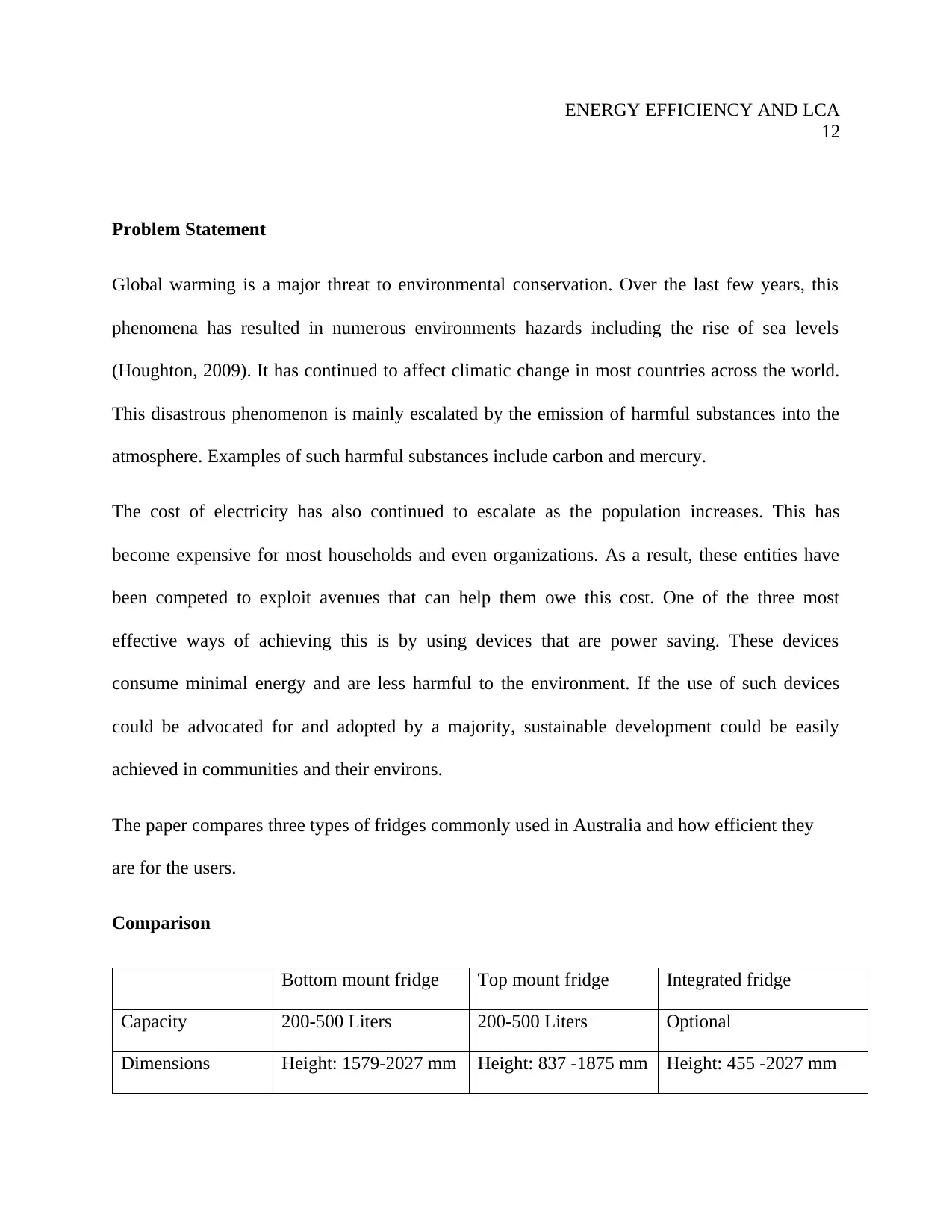
ENERGY EFFICIENCY AND LCA
12
Problem Statement
Global warming is a major threat to environmental conservation. Over the last few years, this
phenomena has resulted in numerous environments hazards including the rise of sea levels
(Houghton, 2009). It has continued to affect climatic change in most countries across the world.
This disastrous phenomenon is mainly escalated by the emission of harmful substances into the
atmosphere. Examples of such harmful substances include carbon and mercury.
The cost of electricity has also continued to escalate as the population increases. This has
become expensive for most households and even organizations. As a result, these entities have
been competed to exploit avenues that can help them owe this cost. One of the three most
effective ways of achieving this is by using devices that are power saving. These devices
consume minimal energy and are less harmful to the environment. If the use of such devices
could be advocated for and adopted by a majority, sustainable development could be easily
achieved in communities and their environs.
The paper compares three types of fridges commonly used in Australia and how efficient they
are for the users.
Comparison
Bottom mount fridge Top mount fridge Integrated fridge
Capacity 200-500 Liters 200-500 Liters Optional
Dimensions Height: 1579-2027 mm Height: 837 -1875 mm Height: 455 -2027 mm
12
Problem Statement
Global warming is a major threat to environmental conservation. Over the last few years, this
phenomena has resulted in numerous environments hazards including the rise of sea levels
(Houghton, 2009). It has continued to affect climatic change in most countries across the world.
This disastrous phenomenon is mainly escalated by the emission of harmful substances into the
atmosphere. Examples of such harmful substances include carbon and mercury.
The cost of electricity has also continued to escalate as the population increases. This has
become expensive for most households and even organizations. As a result, these entities have
been competed to exploit avenues that can help them owe this cost. One of the three most
effective ways of achieving this is by using devices that are power saving. These devices
consume minimal energy and are less harmful to the environment. If the use of such devices
could be advocated for and adopted by a majority, sustainable development could be easily
achieved in communities and their environs.
The paper compares three types of fridges commonly used in Australia and how efficient they
are for the users.
Comparison
Bottom mount fridge Top mount fridge Integrated fridge
Capacity 200-500 Liters 200-500 Liters Optional
Dimensions Height: 1579-2027 mm Height: 837 -1875 mm Height: 455 -2027 mm
⊘ This is a preview!⊘
Do you want full access?
Subscribe today to unlock all pages.

Trusted by 1+ million students worldwide
1 out of 15
Your All-in-One AI-Powered Toolkit for Academic Success.
+13062052269
info@desklib.com
Available 24*7 on WhatsApp / Email
![[object Object]](/_next/static/media/star-bottom.7253800d.svg)
Unlock your academic potential
Copyright © 2020–2025 A2Z Services. All Rights Reserved. Developed and managed by ZUCOL.


